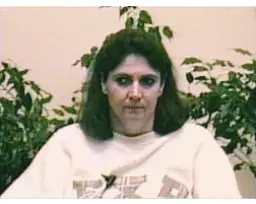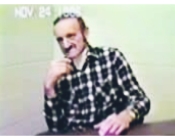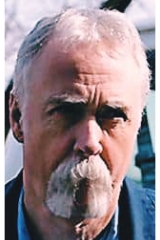DECATUR — Paris is a small farming town in the eastern part of Illinois in Edgar County. For the most part, Paris, which once bragged it was “The Midwest’s most kept secret,” is a quiet town. Not many people would think a city this size would harbor deadly secrets. But it does.
On March 22, 1986, Dyke and Karen Rhoads married at the Lake Ridge Christian Church. Dyke, 27, worked at Chemlawn Corporation in Terre Haute, Indiana. Karen, 25, earned a living at the Morgan Manufacturing Plant owned by Robert Morgan.
The couple moved into a two-story house located at 433 E. Court Street in Paris. They were madly in love and looking forward to spending the rest of their lives together.
Unfortunately for them, that never happened.
Attacked in the Night
Paris resident Terry Newman lived near the Rhoads’ home. At approximately 4:00 a.m. on July 6, 1986, Newman awoke to the sound of breaking glass. When he looked out his window, he saw the Rhoads’ house engulfed in flames.
Newman ran outside to the south side of the burning home. He tried opening the side door, but someone had locked it. Newman then started banging on the door to wake the couple. When that did not work, he ran around to the front door and found it locked as well, but started pounding on it anyway. Newman screamed at the top of his lungs to alert Dyke and Karen, but his efforts failed.
A female neighbor contacted the fire department at 4:39 a.m. They arrived on the scene shortly after. When firefighters were able to get into the house, they discovered the naked bodies of Dyke and Karen Rhoads lying on the second-floor master bedroom floor, with blood all over the bedroom.
The fire had started near the back of the house, and it caused minor damage to the front and second story. There was also minor fire damage in the master bedroom, where the bodies were found.
Edgar County Coroner David Dick performed the autopsy on Dyke and Karen. Dyke was stabbed 28 times from behind, which meant he was probably sleeping when first attacked. Karen received 26 stab wounds and had defensive wounds on her hands, indicating she had woken up and fought for her life.
The autopsy report also showed Dyke had .03 percent alcohol in his blood and .065 percent in his urine. No drugs were found in his system, and no drugs or alcohol were found in Karen’s system.
Obvious Suspect
While Edgar County States Attorney Michael McFatridge said the killings were random, that may not have been the case.
Karen had told one of her sisters and brother-in-law about an incident at work. She was working one evening when a phone call came in. A male caller asked for her Morgan. Karen told the caller that Morgan had just left the office, but she saw Morgan was still in the parking lot when she looked out the window. The caller told Karen, ‘This is a very important call. And I really need to talk to him. Could you run and tell him ‘Chicago’ is calling?'”
Karen went outside to get Morgan, who appeared to be carrying a machine gun. She looked into the open car trunk and saw more machine guns. Karen quoted Morgan as saying, “Why are you here? You shouldn’t have seen this.”
The incident frightened Karen, and she told her brother-in-law, James Tate, that she would turn in her notice and leave her job. James later told the FBI that he said all of this to the Paris PD right after the murders, but no one ever documented that interview.
Tim Busby had once dated Karen. After the two broke up, she maintained a close relationship with his mother, Marilyn Busby. Karen and his mother were having lunch one day at a country club in Danville. She told Busby that an employee at Morgan Manufacturing Company named Mark “Smoke” Burba was giving her a lot of trouble, and it was getting worse. Karen said she would have to get another job.
Smoke Burba was Morgan’s right-hand man. Even though his name was brought up several times in the first two months of the investigation, investigators never questioned him.
Ridiculous Investigation
Even more astonishing, if you can believe it, the police only interviewed Robert Morgan once. Author and retired Illinois State Police investigator Michale Callahan wrote a book on the Paris murders. He wrote, “Investigator Jack Eckerty told investigators years later that Morgan was always a suspect, but “Mike McFatridge steered us away from all other suspects.”
McFatridge focused on two men in particular, and he was determined to take them down, no matter the cost or lies needed to be told to get the job done.
On Jan. 21, 1987, Herb Whitlock, 41, pleaded guilty to unlawful possession of a controlled substance. Edgar County Sheriff’s deputies arrested him on April 5, 1986, while allegedly possessing 15.6 grams of cocaine.
One month after pleading guilty, officers with the Paris PD and Illinois State Police arrested Gordon Randy Steidl, a 35-year-old construction worker, and charged him and Herb Whitlock with the murder of Dyke and Karen Rhoads. For some strange reason, they were not charged with arson at that time.
In March 1987, a Grand Jury hearing convened when McFatridge claimed Steidl and Whitlock killed Dyke and Karen Rhoads over a bad drug deal.


Two Ridiculous Witnesses
McFatridge told the jury the two men met at a local bar on July 6, 1986, with plans to pick up a particular woman. He also said he planned to prove through the testimony of 30-year-old Debra Reinbolt that she, Steidl, Whitlock, and another passenger, Derrell Herrington, left the bar and drove to the Rhoads’ home. While there, Reinbolt held down Karen while Steidl and Whitlock stabbed Dyke with a knife borrowed from Reinbolt. Whitlock then stabbed Karen to death. Reinbolt also claimed Whitlock told her that “… Dyke had to be taken care of.”
According to the Journal Gazette, “Herrington supposedly slept in the car while the others were inside the home. Steidl woke Herrington up, took him into the Rhoads’s home, and while showing him the dead bodies said, ‘This is what will happen to your family if you ever say anything.'”
Afterward, the two men started fires in the kitchen and bedroom with gasoline, McFatridge said.
You will probably never find two more screwed-up, non-credible witnesses in a murder trial than the two in this case.
Lies and More Lies
Herrington, a.k.a the town drunk, is about as non-credible as you can get as a witness. A known alcoholic, he had two felony arrests for deceptive practice and a history of mental health problems.
Herrington claimed Steidl and Whitlock committed the murders because of a drug deal gone wrong with Dyke. He said he knew this because he was there at the crime scene when the crime occurred. But Dyke was a pot-smoker, and that was as far as his drug use went.
Also, Herrington never mentioned Reinbolt being there when he was present.
Herrington recanted two years after his statement, saying police supplied him with beer and whiskey before his interview.
Herrington told Callahan: “Gary Wheat and Jack Eckerty brought me over that night. Jim Parrish came over. They had me drinkin’…beer and wine and whiskey…at the police station and at…Jim Parrish’s residence…The residence where he lives at…I was there day and night…They lied to my wife where I was. They told my wife they was taking me to Indianapolis.”
Five months after Herrington came forward with his statement, Reinbolt came forward. Let me say the prosecution did not know what the word “credible” meant because here’s another NON-credible person who McFatridge should have NEVER called a witness. Why?
Reinbolt was a self-described alcoholic and drug user. Between 1985 and 1987, she had drunk as much as one to two cases of beer and smoked two or three marijuana joints a day. On top of that, she ingested amphetamines and two or three lines of cocaine twice-weekly, the Journal Gazette reported.
So, how was it possible that she remembered anything, let alone almost one year later?
Joke of a Trial and Jury
Whitlock’s murder trial began in May 1987 with defense attorney Ron Tulin representing him. Steidl’s trial started after Whitlock’s in June 1987, and defense attorney John Muller of Charleston represented him.
As mentioned above, Reinbolt and Herrington testified at both trials and gave their accounts of what supposedly happened on July 6, 1986.
From 48 Hours:
“A big mess. Everything went wrong. I mean they were just going to go down there try and scare Dyke, and then things just got out of hand,” says Reinbolt.
Reinbolt said she knew Whitlock and Steidl through her drug use and claimed she saw both of them stabbing Dyke Rhoads.
Asked what was happening to Karen at that point, Reinbolt says, “She’s trying to get off the bed, and I had went over there and was telling her that everything would be okay.”
Reinbolt said she held down Karen while they stabbed her and also claimed her husband’s knife was used in the killings.
Reinbolt’s story impressed police, especially when she accurately described a broken lamp found in the Rhoads’ bedroom.
Two separate juries believed both eyewitness accounts. In 1987, despite no physical evidence tying the men to the murders, their unwavering protests of innocence, and witnesses who said the men were with them on the night of the murders, these two men were convicted. Whitlock was sentenced to life in prison for the murder of Karen Rhoads. Steidl received the death penalty for both murders.
One must wonder how a jury convicted Steidl of BOTH murders when it found Whitlock guilty of Karen’s.
Surprise Assistance
In 1999, Steidl and Whitlock finally received the help they most definitely deserved.
David Protess, a Northwestern University journalism professor, and four of his students began to re-investigate the crime trying to find out who killed the couple.
“It struck me from the start that this was a likely miscarriage of justice,” says Protess, whose investigations have shown that several other men convicted of murder were actually innocent. Protess notes that there was no physical evidence at all that specifically linked the two men to the crime.
“This young couple was stabbed tragically over 50 times,” he says. “These men would’ve been covered in blood; there would’ve been blood in their automobiles; there would have been blood on their clothes. Someone would have seen them in blood. There would have been hair, fiber, something that linked them to the crime scene. Nothing did.” (48 Hours)
Finally, Steidl was released in 2004, followed by Whitlock in 2008.
In 2013, Steidl won a second multi-million-dollar judgment in his case against the people who framed him and put him in prison. The first occurred in 2011 against the Illinois State Police.


True Crime Diva’s Thoughts
When I first heard of this case, I was FURIOUS—NO justice ever for the Rhoads.
We know the motive was NOT to sexually assault Karen Rhoads because no reports mention it. The killers stabbed Dyke first, so it would have been effortless for the attacker to have sexually assaulted Karen before killing her. Yet, no sexual assault. Morgan said a motorcycle gang probably saw Karen outside in her yard and wanted to sexually assault her. Yeah, ok, buddy. If that were the case, why didn’t they kidnap her right then and there?
It was a vicious, PERSONAL crime. There’s no doubt about that.
Two neighbors saw the Rhoads’ house on fire, yet one of them never called for help, and the other didn’t do so until 4:39 a.m., 39 minutes after the first neighbor saw the fire and attempted to wake Dyke and Karen. I never thought much of that until right now. Why on earth didn’t one of them call for help immediately upon seeing the house on fire? Why did BOTH of them go across the street to wake the couple up? My instinct would have been to call the fire department or 911 and then try to wake the residents up. But that’s just me.
One interesting thing, if not infuriating, is that the police never questioned Burba in this case. According to Busby, he had been giving Karen a hard time at work, so in a NORMAL case, he would have been one of the first interviewed by investigators. He wasn’t because of his ties to Morgan.
Now, let’s talk about the two “witnesses.” I want to throw up a little in my mouth, calling them that.
Herrington said he was at the crime scene. So did Reinbolt. Yet, they NEVER saw each other. How is that even remotely possible? If both were there, as they say they were, they would have seen one another at some point during the murders. Reinbolt claimed Herrington must be lying because she was there. Yeah, and she definitely changed her story many times over. Like Herrington, in 1996, Reinbolt also recanted her story. Then during an interview with 48 Hours, she said again that she was there. Well, which is it? Were you or weren’t you there?
I don’t believe either one was anywhere near the crime scene.
Now, Herrington claimed he was drunk on the night of the murders. Reinbolt said she was drunk AND high on drugs. So, how was their memory so sharp months and years after the murders?
It’s a known fact that officials paid Reinbolt $2,000 for her “story” and supplied Herrington with alcohol. So, it would not surprise me if McFatridge or one of Morgan’s goons paid off and/or threatened the jury members. Paris, IL is a shady town, and McFatridge wasn’t exactly Prosecutor of the Year. He was a downright sleazeball and KNOWN cocaine user.
I know that if I had sat on the jury, I would have looked at the fact that these two losers were too drunk or high to be able to recount events of that night with such precise memory.
Morgan was and still is a wealthy businessman in Paris who owns several businesses in that town. He also has donated significant amounts of money to Illinois politicians. So much so that when Callahan wanted to reopen the case, Callahan’s superiors told him that it was “too politically sensitive.” His response? “Since when is murder too politically sensitive?”
Right on, brother. Hmm, do ya think the government officials are protecting this man? Not only was the ISP protecting Morgan, so were the Paris PD and the Illinois politicians he financially endorsed.
It makes sense that Morgan hired people to kill Karen because of what she saw in the parking lot that evening. Someone murdered her shortly afterward. Not only that, but she was going to turn in her resignation. I doubt Morgan liked that very much.
If this were an investigation on the up and up, police would have suspected Morgan. They interviewed him only once. Morgan also had connections with a local motorcycle gang, Sons of Silence, in 1986. Some people believe Morgan hired them to kill the Rhoads and commit other murders, which also remain unsolved to this day.
The only person who had anything to gain from killing this couple is Morgan by getting rid of the only witness to his illegal activities. With her out of the picture, he could continue without worrying about getting caught. As we know now, he had nothing to stress over. Ever. But Karen’s permanent silence was far more important to him than just to let her walk away, threatening to expose him for the person he really was.
Recently, I came across a website trying to claim someone else killed the Newlyweds. One of the owners of the site worked for Morgan at one time. Need I say more?
UPDATE: Derrell Herrington passed away in 2007 at age 66. Debra Reinbolt still lives in Illinois.
Last updated December 2021.




